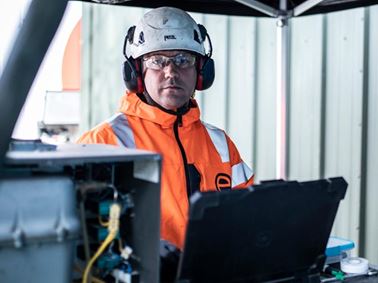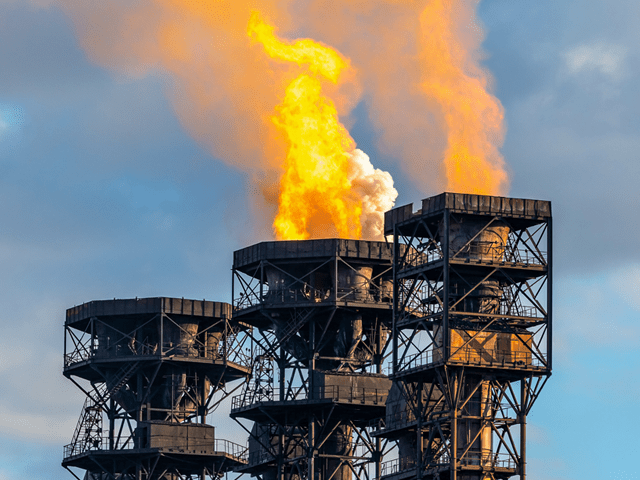High-Fidelity CFD Modeling to Determine Flare Destruction Efficiency for Methane Emissions

By Engaged Expert
Tom ElsonMeet our Digital Engineering expert Tom Elson and learn more about his expertise in CFD which enhances our projects with innovative solutions.
BACKGROUND
Emissions and their impact on the environment are a major focus for companies and operators in the Oil and Gas Industry. Methane emissions from flaring are particularly concerning, as methane is 26 times more potent as a greenhouse gas than carbon dioxide. Previous studies suggested a flare destruction efficiency between 98-99%, but new technologies and methods have brought this into question. Element Digital Engineering developed a methodology using Computational Fluid Dynamics (CFD) to predict the methane destruction efficiency of an operational flare. Our client sought to determine the efficiency of their flare under various conditions to identify opportunities for improvement.
THE CHALLENGE
Our client needed to understand the operational methane destruction efficiency of their flare under a range of conditions. This required a detailed analysis of how different factors, such as crosswind speeds and the positioning of ignition sources, impact the efficiency. The primary objective was to identify areas for improvement to minimize methane emissions and meet environmental regulations.
THE SOLUTION
Element Digital Engineering created a comprehensive CFD model of the client's flare system. This model included:
- A 3D representation of the flare geometry, including flare tips, ignition sources, wind fences, and platforms.
- Wind speed calculations at the flare tip using an atmospheric boundary layer profile.
- Transient calculations of species transport with a complex chemistry combustion model to predict flare performance accurately.
- Extensive monitoring of combustion reactants and products to ensure precise and reliable destruction efficiency measurements.
The model evaluated the flare under normal, startup, and extreme operating conditions. Sensitivity studies helped determine the combustion reaction temperatures necessary to ensure accurate destruction efficiency reporting.
THE RESULT
The analysis revealed a wide range of destruction efficiencies, from 52% to 95%, depending on the operating conditions. It highlighted the sensitivity of flare efficiency to crosswind conditions and the positioning of ignition sources. For example, at mean operating conditions with a 20th percentile crosswind speed, the methane exit velocity was significantly lower than the crosswind speed, causing considerable methane dispersion and reduced combustion efficiency.

Visualizations of the combustion profile under different crosswind velocities provided insights into the mechanisms impacting destruction efficiency. The study also identified a design improvement opportunity for the flare tip, suggesting adding a dedicated pilot for the low-pressure (LP) flare to enhance overall efficiency.

The findings enabled our client to develop plans to reduce greenhouse gas emissions and improve flare efficiency. This case study demonstrated that destruction efficiency varies widely across different conditions, often falling below the previously assumed 98-99%.
Ready to optimize your flare destruction efficiency? Contact our expert team today.
Find related Resources
Related Resources

Flare Emissions Modelling for the British Flame Research Committee
Discover how Element Digital Engineering's CFD simulations revealed overestimated flare destruction efficiency in the Oil & Gas industry, highlighting potential environmental impacts

Optimizing Separator Process Performance with Fluid Dynamics Modeling
Discover how Element Digital Engineering's fluid dynamics modeling optimized a vertical scrubber's performance, resolving poor liquid droplet capture and significantly increasing plant throughput.

Stress analysis of low-cost, low-weight safety device used to deflect jet fires
Discover how our stress analysis confirmed the integrity of a low-cost, low-weight safety device designed to deflect jet fires, enabling significant cost savings and global promotion.
Related Services

Engineering Design Services
Enhance your design process with our Engineering Design Services for faster, more precise market-ready solutions. Discover more today.

Modeling and Simulation Services
Optimize your project with our modeling and simulation services. Our expertise ensures cost-effective, compliant solutions. Enhance your project today.

Biogas Engine and Flare Emissions Monitoring Services
Biogas and waste operators work with Element to monitor the biomethane and flare emissions on their sites.
